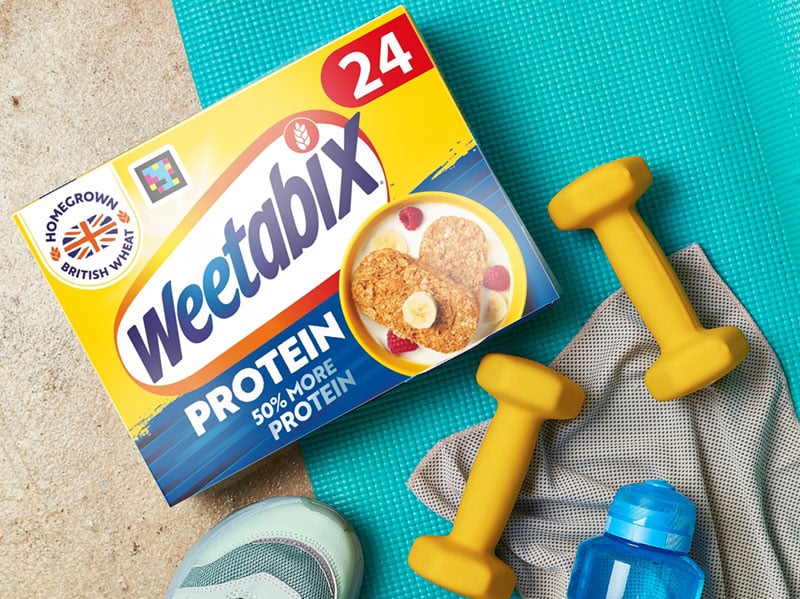It’s no secret that protein-packed cereals can help us start the day protein positively. But how else can we increase our protein intake?
The benefits of protein
We are what we eat, and it’s important to include foods that contain protein at mealtimes and as snacks, spread throughout the day, as part of a healthy diet and lifestyle. Here are some of the benefits of protein:
- Strong bones: During childhood, protein is needed for normal bone growth and development.
- Build muscles: Protein helps to build and maintain muscles.
- A healthy lifestyle: Protein contributes towards the maintenance of normal bones as part of a healthy diet and lifestyle.
Which foods have protein in them?
If you’re looking to keep up or increase your protein intake, here are some handy sources of plant-based protein and animal protein.
| Food | Amount of protein (per 100g) |
|---|---|
| Chicken breast (grilled, no skin) | 32g |
| Pork chop (lean, grilled) | 31.6g |
| Beef steak (lean, grilled) | 31g |
| Reduced fat cheddar | 29.2g |
| Tuna (canned in brine) | 24.9g |
| Salmon | 24.6g |
| Almonds | 21.1g |
| Egg (whole, boiled) | 14.1g |
| Rice | 10.9g |
| Tofu (steamed) | 8.1g |
| Red lentils (boiled) | 7.6g |
| Chickpeas (canned) | 7.2g |
| Plain Greek-style yoghurt | 5.7g |
| Whole milk | 3.4g |
Source: British Nutrition Foundation
Is there protein in cereal?
Yes, cereal is a source of protein, though some cereals are higher in protein than others. Examples of cereals that are a plant-based source of protein include:
- Weetabix Protein
- Weetabix Protein Crunch
- Oatibix
- Ready Brek
- Crunchy Bran
How much protein do you need?
In the UK, the reference daily intake for protein, for a typical adult is 50g.
Anyone with a medical condition in search of dietary advice should consult their GP or a registered dietitian. Athletes should consult a registered sports dietitian.
Most people should be able to get all the protein they need from a varied, balanced diet.
How to increase your protein intake
Want to make protein a priority? Here are some easy ways to meet or increase your protein intake.
- Try a high protein cereal hack. Get more protein in your breakfast cereal by adding ingredients like peanut butter, oats and chia seeds – perhaps with a dash of soya milk.
- Embrace plant-based protein. Combine a variety of pulses, wholegrains (including high fibre breakfast cereals), beans, nuts, seeds and soya foods such as tofu throughout the day. This can help you increase your protein intake.
- Choose protein-based snacks. This could include a handful of unsalted nuts, hummus and veggie sticks, low fat Greek yogurt with fruit and seeds, and high fibre protein cereals such as Weetabix Protein or Protein Crunch with milk.
Does Weetabix have protein?
Yes, some Weetabix cereals contain protein. This includes Weetabix Protein, which features 19g of protein per 100g, or 7.6g per serving. This protein-packed cereal has 50% more protein than an average, ready-to-eat breakfast cereal.
Or you can choose many other favourites like Ready Brek and Crunchy Bran – the perfect fuel to start your day!
We’re proud that Weetabix is chosen by millions as a healthy breakfast option. Not only do Weetabix Protein, Oatibix and Ready Brek provide protein – they’re high in fibre, and low in salt, sugar and saturated fat. That’s why these Weetabix cereals have all ‘green traffic lights’ on the front of the pack) – and we intend to keep it that way!
Protein-powered breakfast ideas
Maximise the protein in your Weetabix breakfast bowl with these awesome recipe ideas.
- Protein bowl – pair two Weetabix Protein biscuits with one sliced kiwi fruit, plus a dollop of Greek yoghurt with chopped pistachios and toasted pumpkin seeds.
- Protein and fibre mix – peanut butter and sliced banana on Weetabix Protein, with milk of your choice. What’s not to like?
- Protein passion – passion fruit meets protein power in this delicious yoghurt-laden breakfast bowl.
